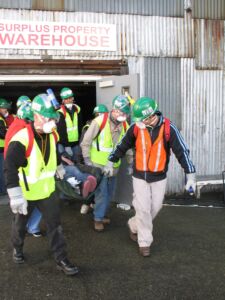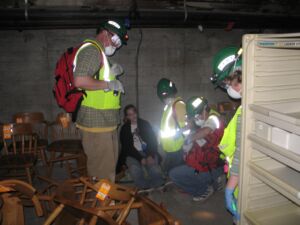By Scott Preston
When I ran the UW CERT team, I would actively seek out members from the hard of hearing/deaf community and the blind community. Dana Platt, the State 9-1-1 TTY manager at that time was someone who volunteered on several occasions. The UW would pay for an interpreter to assist her and me, since I don’t speak sign language (although I am half-deaf).
The value was recognized on several fronts:
1- The community in question had an active role in the UW’s emergency training for the CERT team. This is the very definition of inclusion.
2- The CERT members had the opportunity to practice serving and assisting members from that community and learn how to manage the needs of the individual, in the context of the disaster. This also meant having to think critically about how a CERT team would assist a blind or deaf person. Some examples: The common CERT verbal triage (“If you can hear me, come to the sound of my voice”) would not work for deaf person. Also, we did a lot of work in absolute darkness, where the practice scene would only be lit by headlamps. Shining a light in the face of someone who is deaf immediately removes their only means of communication because they can’t see hands or read lips through the blinding light. Another example is that great care and thought must be given to how patients are treated for injuries, if they are reliant on their hands to communicate or their ears to tell them about an environment that they can’t see. We tried to help the CERT volunteers to recognize the value of slowing down and assessing the specific needs of the patient, based on what they were able to discern by their initial size-up and patient evaluation.
For example: If a patient with a wheelchair were to be rescued from a building, every effort should be made to bring the wheelchair too or have some alternate provision that is as accommodating as possible, given the situation at hand. A blind patient with hand injuries should be treated in such a way as to preserve as much mobility in the fingers and hands as possible without risking additional injury. This way the at patient can still sign in order to communicate.
3- It was good for me as one of the UW’s emergency managers to have a more in-depth understanding of the needs of those communities. Unfortunately, many
emergency management programs simply don’t have enough support to adequately plan for the additional resources needed to properly assist the members of our community who may have additional special needs.

We had a similar approach for persons who spoke some other language besides English. We’d try to find native foreign-language speakers to serve as role-play victims and ask them not to speak any English at all during the course of the exercise. In some cases, our CERT members spoke that same language and things got easy for the team. In other cases, they had to improvise. Eventually, we issued pictographic talking cards that would help them communicate basic first aid concepts. We were doing good things and starting to tackle some of the tough issues that CERT teams face, but unfortunately, the grant went away and so the program was left unfunded.
Question: Do you have any idea what the UW is doing now in terms of EM and Preparedness when it comes to people with ADA needs?
Not since I’ve been gone. However, there was a study conducted in 2006 while I was there, You can read about it here: https://www.washington.edu/uwem/resources/other-disaster-resources/special-needs-resources/
If you want to reach out to UW Emergency Management, here’s their contact information:
https://www.washington.edu/uwem/contact-us/


